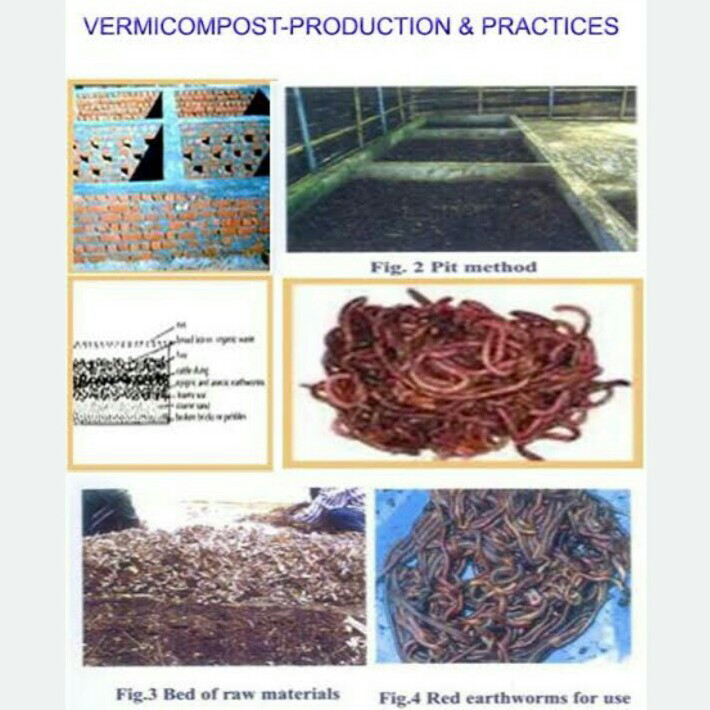Application of vermicomposting in agriculture and horticulture practices
Application of Vermicomposting in Agriculture and Horticulture Practices :
1. Introduction to Vermicomposting : Vermicomposting is the process of using earthworms to decompose organic waste materials, turning them into nutrient-rich compost known as vermicast. This process helps recycle organic waste while enhancing soil fertility and structure.
Key components of Vermicomposting:
Earthworms: Primarily Eisenia fetida and Lumbricus rubellus are used.
Organic waste: Kitchen scraps, farm residues, animal manure, and other biodegradable materials.
Vermicast: The end product, rich in nutrients like nitrogen, phosphorus, potassium, and trace elements, ideal for soil amendment.
2. Benefits of Vermicomposting in Agriculture :
The application of vermicomposting in agriculture offers numerous advantages, including:
Soil Fertility Improvement:
Vermicompost is rich in nutrients that help replenish soil fertility, enhancing crop yields.
It improves the cation exchange capacity (CEC), enabling better nutrient retention in the soil.
Enhanced Soil Structure:
Vermicast increases the soil's porosity, promoting better root growth and water retention.
It improves aeration and drainage, reducing soil compaction.
Reduction in Chemical Fertilizer Use:
Vermicompost can reduce the need for synthetic fertilizers, making farming more sustainable and reducing costs.
It minimizes the environmental impact of chemical fertilizers, which can degrade soil health over time.
Increased Microbial Activity:
Vermicompost is rich in beneficial microbes that help improve soil biodiversity and fight soil-borne diseases.
The microbes in vermicast enhance nutrient cycling and decomposition processes in the soil.
Soil pH Regulation:
Vermicompost can help stabilize the pH of the soil, making it more neutral and suitable for a wide range of crops.
Improved Water Holding Capacity:
Vermicompost increases the water-holding capacity of soil, which is beneficial for drought-prone regions or during dry spells.
Organic Matter Addition:
It adds organic matter to the soil, improving its long-term fertility and structure.
Application in Agriculture:
Crops: Vermicompost is particularly effective for crops such as vegetables, grains, legumes, and fruit trees.
Fertilization: It can be applied directly to the soil as a soil amendment, mixed with irrigation water, or used as a foliar spray for certain crops.
3. Benefits of Vermicomposting in Horticulture :
Horticulture involves growing fruits, vegetables, flowers, and ornamental plants. Vermicomposting plays a significant role in this field as well.
Enhancement of Plant Growth:
Vermicompost provides slow-release nutrients that support healthy plant growth, leading to better yields and robust plants.
It helps in the growth of healthy roots, leading to better establishment and resistance to diseases.
Improved Flowering and Fruit Set:
Plants grown with vermicompost have improved flowering and fruiting, thanks to the balanced nutrition it provides.
Pest and Disease Control:
Vermicompost, due to its microbial content, can help suppress certain soil-borne diseases and pests, reducing the need for chemical pesticides.
Soil Quality Improvement for Landscaping:
In landscaping and ornamental gardening, vermicompost improves soil texture and supports healthy, aesthetically pleasing plants.
Application in Horticulture:
Flowers and Ornamental Plants: Vermicompost can be mixed with the soil or applied as a top dressing to promote flowering and vibrant colors.
Fruits and Vegetables: Vermicompost enhances fruit yield, flavor, and nutritional value in horticultural crops.
Lawns and Gardens: Vermicompost can be used to enrich soil for growing lush lawns and garden plants, improving the growth of grass and ornamental plants.
4. Vermicomposting Techniques for Agricultural and Horticultural Use :
There are several methods of applying vermicompost effectively in agriculture and horticulture:
Soil Application:
Directly applying vermicompost to the soil either by broadcasting or mixing into the soil during planting or tilling.
Fertigation:
Vermicompost can be dissolved in water and applied through drip irrigation systems (vermi-tea) for a more efficient nutrient supply.
Foliar Application:
Vermi-tea or liquid compost can be sprayed on plant leaves to provide nutrients directly.
Compost Tea:
Vermicompost can be brewed into a liquid, which is used as a foliar spray or root drench. This liquid fertilizer is rich in beneficial microbes and nutrients that plants can absorb quickly.
5. Application Guidelines for Vermicomposting in Agriculture and Horticulture :
Quantity and Timing:
For crops, a recommended dose is about 5-10 tons of vermicompost per hectare, depending on the soil’s nutrient deficiency.
Apply it before sowing, planting, or during early stages of plant growth for best results.
Proper Mixing:
Vermicompost should be well-mixed with the soil to ensure uniform nutrient distribution.
Watering Practices:
Ensure that the soil is sufficiently watered after applying vermicompost to activate microbial activity.
Application Frequency:
Vermicompost can be applied annually or biannually, depending on the soil fertility status and the type of crops grown.
6. Challenges in Vermicompostin :
While vermicomposting has several benefits, there are some challenges:
Initial Setup Cost: Establishing a vermiculture system (earthworm farm) can require some initial investment in infrastructure.
Labor and Time: Maintaining a healthy worm population requires attention to the right moisture, temperature, and feeding conditions.
Quality Control: Ensuring the quality of the vermicompost (free from contaminants) can be a challenge in large-scale production.
7. Conclusion :
Vermicomposting provides a sustainable and efficient way to improve soil health, reduce waste, and reduce dependency on synthetic fertilizers in agriculture and horticulture. By integrating vermicomposting into agricultural and horticultural practices, farmers and gardeners can achieve healthier plants, higher yields, and improved soil quality, contributing to more sustainable farming and gardening systems.



